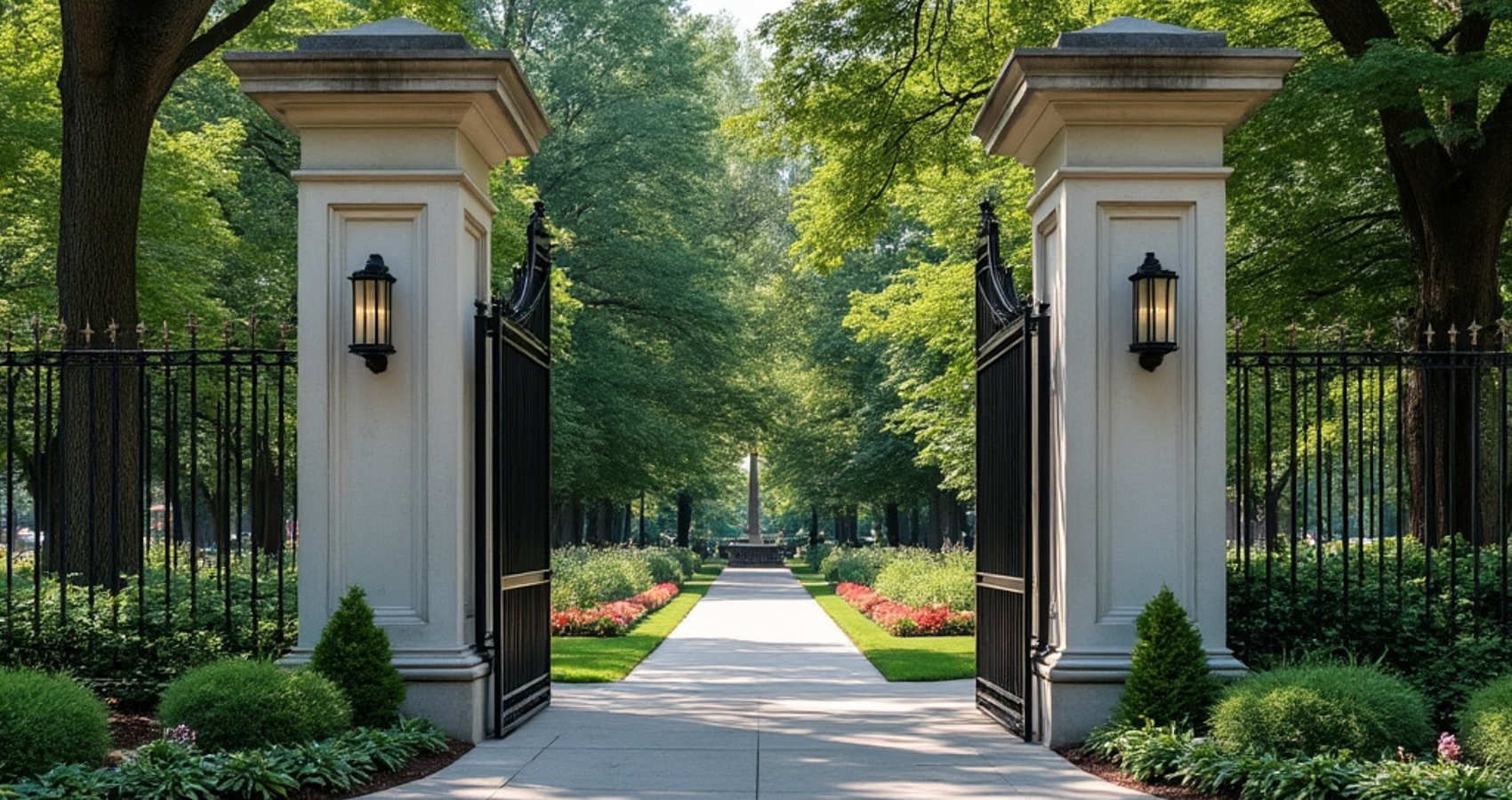On Being a Modern Dead Person
written by: Andrea Eschen
My ninety-four-year-old mother reminded me for the fifth or sixth time that she wanted one-third of her ashes scattered in the sanctuary garden at St. John’s Episcopal Church. Another third was to be placed in my father’s grave at the Mountain View Cemetery in Oakland, California. She hadn’t figured out the destination of the final third. Standing over the sink rinsing the dinner dishes, I thought, She’d better make up her mind soon.
Stooping to nestle the pans in a cupboard, I wondered if I’d ever visit her gravesite. I’d had seventeen years to visit my father at his family’s tombstone, but making the trek to Oakland, a thirty-five-minute drive from my mother’s home, had never occurred to me. Love for my father did not transmit through a granite slab. However, with my mother approaching the end of her life, the convenience of paying a call on my parents―together―came to mind.
Four months later, dead family members still stalking my thoughts, I drew up an itinerary for a trip to Chicago, made plane reservations, and packed my suitcase. In addition to museums, architectural landmarks, and parks, I wanted to visit Graceland Cemetery, where my mother’s relatives, the Falkenau family, were buried. One family member, Victor Falkenau, my great-grandfather, intrigued me. His story compelled me to write a book. Perhaps during my trip to Graceland, some facts about him would bubble up to the surface. My visit also might help my mother decide on the final third of her ashes, not to mention me on my own remains.
After landing in O’Hare and settling into an Airbnb, over the next three days I rushed up the steps into the Art Institute of Chicago and the Chicago Cultural Center, onto the paths into Lincoln and Millenium parks, and down the ramp for the architectural boat tour. One more tour, one more site, one more stop. In those places, I didn’t confront my mother or myself. In the final hours of the last afternoon, before the trip ended, I clamored up the stairs to the red line of the “L” headed to the cemetery. I glanced at my watch to make sure I’d have enough time to wander the grounds before it closed at 4:00. Getting off at Sheridan, I strode eleven minutes along a tree-lined street, cars zipping by, until I arrived at the main entrance on Clark and Irving.
The gate to one of Chicago’s largest and most historic final resting stops was surprisingly unimposing―two tall, simple stone pillars. This entry did not resemble the original when Graceland was created in 1860. After visitors hopped off the twice-daily horse railway or omnibus ride from the city to the cemetery, they passed through a two-story stone arch with the cemetery’s name carved into the crown. Atop rested a bell tower. Spacious visiting rooms stood at each side of the gateway. One side served as an office and chapel. The other as a vault or public receiving tomb where the spaces on two floors suited visitors’ needs to store their loved ones until they identified a plot. A Chicago Tribune reporter in 1862 waxed about the chapel and visiting rooms, saying they were “free from that dreary look which at such places seems premonitory.” These buildings, with “spiritual looking pictures on its walls and a canary singing blithely in its cage,” looked “positively cheerful.” Chicago residents who owned plots stored winter plants in a “capacious and elegant greenhouse” annexed to the chapel.
Impressive entrances to former rural cemeteries like this one signaled leaving the day-to-day world of the living and entering the realm of the dead. Landscape designers razed the original gate only thirty-six years after its construction and replaced it with a wrought iron gate set between two unassuming stone pillars. A new chapel obscured by greenery provided visitors more privacy and tranquility.
I passed through the entrance onto the hallowed grounds. Though this gate didn’t hold the grandeur of the original or separate me from the honking horns on North Clark Street, I wondered what revelations might occur about my mother’s and my eventual resting places and what messages I’d pick up from my underground relatives before I returned through the gate to the L. I strolled by knolls, winding paths, and landscaped family lots, shaded by maple, oak, locust, and walnut trees―areas so pleasing visitors wanted, someday, to be buried there.
The ideals of the park’s designers in 1859 still held. They called for preserving the natural beauty of the ground and the existing trees; planting vegetation that offered shade and shelter but did not obstruct views; and providing roads for carriages and walkways for pedestrians. In one hundred and fifty years, carriages were long gone but not much else had changed.
I was the first living family member to walk through those gates and drop in on the Falkenaus. Morris, Therese, Louis, Victor, Emil, Harry, Helen, Herbert, Hatty, Ruth, and Esther―three generations buried between 1894 and 1988―didn’t have immediate kin left.
Who will visit my remains? What will my mother’s ashes convey to me? I questioned if, from six feet under, I’d offer solace and wisdom to my children and their descendants. Should I give my family a serene and concrete remembrance of my existence or leave them to reminisce by scrolling through my moribund Facebook and Instagram posts? Paging through the hardcover books of family photographs I’ve made for them will offer snapshots of our lives that we almost forgot before the next chapter began. I won’t have them store me boxed up in a closet as my mother did with her aunt who had requested she scatter her ashes on 11,800 foot Mt. Assiniboine deep in the Canadian Rockies, a place too remote for a weekend outing.
Before the trek to Graceland, I had spent seven years reading hundreds of articles about Victor Falkenau in newspapers and construction journals from Chicago, Pittsburgh, New York City, and Muscatine; scrutinized letters and poems to his children; scoured websites; and stared at photographs. I’d leafed through hundreds of brittle tattered pages in archives. The son of immigrant Jewish parents, Victor arrived in Chicago from Manhattan in 1882 as a twenty-two-year-old union bricklayer. He became an esteemed building contractor, erecting some of the city’s iconic buildings during the Gilded Age. He built the Chicago Stock Exchange, the Auditorium Annex on Michigan Avenue (now the elegant Congress Plaza Hotel), and the Victoria Hotel in Chicago Heights, built for the 1893 World’s Columbian Exposition. Fighting the building unions’ sympathetic strikes, he turned into a union buster. He then had to protect his family from the unions’ revenge in which they threatened to kidnap his wife and three young daughters and kill him.
Like my mother and those who came before her, I also needed to decide about my remains. When I’m ninety-four, I don’t want my children speculating about what to do with me. I could choose to be outdoors forever, under the stars, instead of cramped underground in a box or confined in an urn. My environmentally conscious children could mix my ashes into the soil to nourish a tree, and ponder this healthy living being reaching to the sky. Resomation, or “water cremation”, uses alkali and a water-based substance to break down a body to liquid and ash. The liquid can be recycled by watering a garden or tree. Ecologists tout this method because it uses one-fourth of the electricity of flame-based cremation and produces less pollutants and carbon dioxide. Some companies place ashes into a natural reef mold and deposit it in the sea. I’d help build back the eroding coral reefs. Curious sea life, or snorkeling children, would swim by.
***
In the late 1850s, as Chicago’s public health officials grew concerned that the borders of City Cemetery, infringing on the shores of Lake Michigan, were contaminating the city’s water supply. Local physician John H. Rauch and other doctors claimed, “the emanations of the dead” were “injurious to health and destructive of life.” These gases, medical professionals believed, helped spread diseases, such as cholera. Trees, on the other hand, absorbed the dangerous gases. A concerned, and wealthy, Chicago citizen who needed a plot for his deceased four-year-old son bought 122 acres two miles outside the city limits to build a rural cemetery.
The original landscape designers created expansive views, a small lake, and plantings of native trees and shrubs. They designed the landscape to overshadow the monuments and tombstones sprinkled around the curves of the grassy paths. No fences separated the departed. The Chicago Tribune in 1862 encouraged its readers to visit “this beautiful city of the dead.”
The rural cemetery movement began in the 1830s, as church cemeteries, municipal burial grounds, and town commons began to fill up and overflow. When floods occurred, coffins crammed into a small underground space, often piled on top of one another, rose, broke open, and spilled bodies into the streets. The municipal government needed to rebury them elsewhere. Furthermore, city residents believed burial grounds harbored diseases. They grumbled that cemeteries were expensive to maintain, and they needed the land as cities expanded and real estate prices rose. Urban dwellers turned toward burial places beyond the cities, where the deceased could truly rest in peace.
Graceland soon became the eternal home for Chicago’s well-to-do, including my great-grandfather and his family. Victor was buried among industrialists, philanthropists, businessmen, mayors, and politicians. Graceland was also called the “Cemetery of Architects.” He chose to rest not only with his parents and siblings, but with his colleagues and business partners. He and these architects had created the city’s quintessential buildings and the world’s first skyscrapers. They were now lying underground, far from the ornamental cornices and towering steel-frames of their creations. Today, few people know of Victor Falkenau or can recite the buildings he constructed.
***
I followed the map as I wandered down the undulating Main, Center, and Lake asphalt paths to the far end of the cemetery edging West Montrose Avenue. When I found Lot 10, my head bowed as I stood in front of the three-tiered, gray granite and marble tombstone with “FALKENAU” carved into the second tier. I stepped around chunks of green grass and patches of weeds surrounding each of the eleven family members’ footstones. I stared at the uneven turf, hoping my eyes and sheer will would pierce the dirt and connect with my ancestors below.
The sun’s warmth relaxed my shoulders and breathing. I listened, waiting for my relatives to speak to me. Why did Victor’s business go bankrupt? Why did he become Christian? How did his parents face the grief of losing half of their children? I wondered if they thought about future generations—like mine. But they remained silent.
I clutched a photograph of the plot card recording the data of the dead in Lot 10—name; birth, death, and interment dates; age at death (in years, months, and days); and location in the cemetery—but the card left me to surmise much of what might have happened between those birth and death dates.
Victor and his siblings had bought the 840-square-foot plot for, as it turned out, $840 on February 1, 1895, the day their mother died from a two-year bout with breast cancer. Notes penciled in red on the card disclosed they had buried their father, Morris, for the second time here. The first time took place thirteen years earlier, after his death from consumption on the Portuguese island of Madeira, where he had been receiving Europe’s state-of-the-art treatment for the disease. The family had shipped his embalmed body to the Cypress Hills Cemetery in Brooklyn. When they brought Morris to Graceland in November 1895, they also moved three of their own siblings who had died in infancy in New York City, where the Falkenau children had grown up.
At Graceland, all but the oldest brother, William, found a place at one another’s side. He remained in the English Cemetery on Madeira, where he, too, had died from consumption, two months after his father. His family memorialized him by having his name and date and place of death carved into the Graceland tombstone. Perhaps the family believed they could compensate in death for those times in life when the Atlantic Ocean separated some children who stayed in New York while their parents and siblings resided in Madeira.
Since I wasn’t going to hear from my ancestors, they had to listen to me. I sat on the ledge of the second tier of the tombstone, closed my eyes, and lowered my head. The granite beneath my skin was warm, heated by the sun. I thanked Victor and his parents for the legacy—curiosity about the world, intellectual and philanthropic aspirations, interest in languages and travel—they had gifted me.
I hauled myself up from the rock, stood at each footstone to say goodbye and headed to the path leading me off the grounds. Following the map on my phone, I wended through the curving paths and up and down slight inclines to the exit. I stepped through the stone gates, leaving the serenity of the dead to the din of cars whizzing to their destinations. Clangor returned me to the present. My ancestors didn’t resolve my queries about their family life, trips abroad, and favorite subjects in school, or their losses and grief, but standing on top of their remains I generated a connection to them—my family, and my history.
***
I returned home from Chicago with my questions unanswered. I still faced the logistics of my mother’s remains and uncertainty about mine. I asked my children how and where they wanted to remember me. One son assured me he would come to my burial spot, if I had one, but he didn’t need a physical place. My daughter said vegetarian cookbooks with my scribbles in the margins, favorite books, and coats will substitute for visits and help her remain close to me.
A year after the trip to Graceland, my mother died following a short illness. She never figured out where she wanted the other third of her ashes to be spread, so my siblings and I changed the math. We buried half with my father and his family at Mountain View, a 209-acre rural cemetery. She’s overlooking the Oakland hills and the San Francisco Bay. We placed the other half in a sun-drenched bed of flowers and shrubs at St. Johns, in the church’s sanctuary garden.
My parents’ gravesites, immersed in natural landscapes, offer me a place to remember them, but there are other ways. It’s wearing my mother’s colored scarves, many of which I gave her, that revive her vibrancy. A Mexican sterling silver necklace and cuff bracelet bring back her understated elegance. Her gold wedding band on my right ring finger symbolizes infinity or eternity and her everlasting love. It’s not being in the ground but above it that brings the dead back to life.
As a future modern dead person, I don’t want to leave anything undone. My loved ones won’t wait for answers that will never come. I’ll be available to my family, not underground, where I could be moved but under a bench made of recycled materials overlooking a lake or a mountain. My children will place a QR code in the nameplate to upload photographs, videos, images, and my voice. They’ll have heard me before, but this time they’ll listen more closely.
- On Being a Modern Dead Person - November 16, 2024



